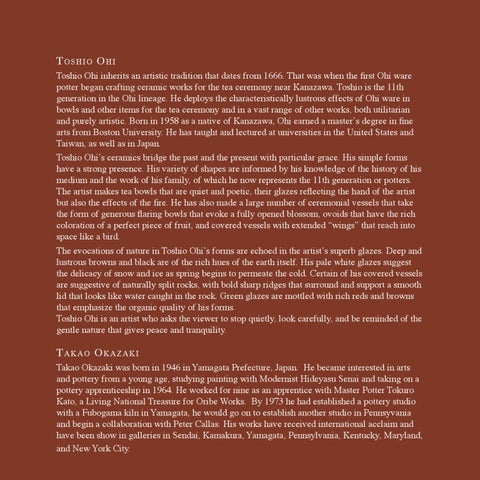Toshio Ohi
Toshio Ohi inherits an artistic tradition that dates from 1666. That was when the first Ohi ware potter began crafting ceramic works for the tea ceremony near Kanazawa. Toshio is the 11th generation in the Ohi lineage. He deploys the characteristically lustrous effects of Ohi ware in bowls and other items for the tea ceremony and in a vast range of other works, both utilitarian and purely artistic. Born in 1958 as a native of Kanazawa, Ohi earned a master’s degree in fine arts from Boston University. He has taught and lectured at universities in the United States and Taiwan, as well as in Japan. Toshio Ohi’s ceramics bridge the past and the present with particular grace. His simple forms have a strong presence. His variety of shapes are informed by his knowledge of the history of his medium and the work of his family, of which he now represents the 11th generation or potters. The artist makes tea bowls that are quiet and poetic, their glazes reflecting the hand of the artist but also the effects of the fire. He has also made a large number of ceremonial vessels that take the form of generous flaring bowls that evoke a fully opened blossom, ovoids that have the rich coloration of a perfect piece of fruit, and covered vessels with extended “wings” that reach into space like a bird. The evocations of nature in Toshio Ohi’s forms are echoed in the artist’s superb glazes. Deep and lustrous browns and black are of the rich hues of the earth itself. His pale white glazes suggest the delicacy of snow and ice as spring begins to permeate the cold. Certain of his covered vessels are suggestive of naturally split rocks, with bold sharp ridges that surround and support a smooth lid that looks like water caught in the rock. Green glazes are mottled with rich reds and browns that emphasize the organic quality of his forms. Toshio Ohi is an artist who asks the viewer to stop quietly, look carefully, and be reminded of the gentle nature that gives peace and tranquility.
Takao Okazaki
Takao Okazaki was born in 1946 in Yamagata Prefecture, Japan. He became interested in arts and pottery from a young age, studying painting with Modernist Hideyasu Senai and taking on a pottery apprenticeship in 1964. He worked for nine as an apprentice with Master Potter Tokuro Kato, a Living National Treasure for Oribe Works. By 1973 he had established a pottery studio with a Fubogama kiln in Yamagata, he would go on to establish another studio in Pennsyvania and begin a collaboration with Peter Callas. His works have received international acclaim and have been show in galleries in Sendai, Kamakura, Yamagata, Pennsylvania, Kentucky, Maryland, and New York City.
